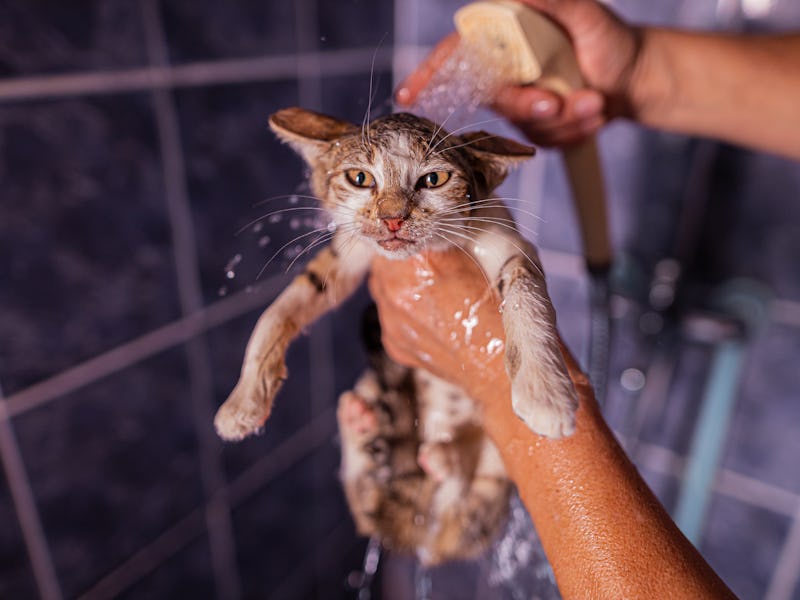Should I Give My Cat A Bath? A Veterinarian Explains Why Cats Can Skip Them
The average healthy pet cat, indoor or outdoor, won’t need a bath.

Cats are apex predators, optimized for sprinting and stalking. But perhaps the most ingenious aspect of their design is that they come with a built-in shower. Cat tongues are amazing little instruments that wick dust and dirt from furry pelts with every lick. This cleaning method may seem unhygienic to us, but it’s quite effective.
In spite of this evolutionary miracle, some cat owners still feel the need to bathe their pets with soap and water (and broadcast it.) But if you were hoping to become Internet-famous for treating your kitty to luxurious bubble baths, you may want to find another avenue for cat clout, for both your sake and your pet’s. Cat science tells us this isn’t necessary — but of course, there are always exceptions to the rule.
“Generally speaking, the average healthy cat will not usually need a bath,” Bruce Kornreich, veterinary cardiologist and director of the Cornell Feline Health Center, tells Inverse. The typical pet cat, indoor and outdoor, cleans itself meticulously and sufficiently. (In fact, over-grooming to the point of creating bald patches may be a sign of anxiety.) If you’re still not convinced, consider the risks that a water bath brings.
“If cats don't like to be bathed, that can stress the cat [and] negatively impact the relationship that an owner has with a cat,” Kornreich says. Most cats notably hate water, so trying to force-bathe your fur baby may go catastrophically for you both. It could even end with a claw-induced injury and a wet, panicked kitty. Kornreich adds that splashing water where it’s not meant to go carries health risks like ear infections and conjunctivitis, a.k.a. pink eye.
According to Kornreich, human-style cleaning could also “have inappropriate effects” on their skin pH, the delicate chemical balance between acid and alkaline. Cat skin pH averages about 6, smack in the middle of the scale, which means that pushing that figure even slightly in either direction could irritate the skin unnecessarily. Kornreich emphasizes that pet owners shouldn’t use products intended for humans on their pets because there is indeed cat-formulated shampoo.
So when is it appropriate to bathe your cat? There are only a few situations, says Kornreich. A case of ectoparasites, where parasitic critters, often fleas, find themselves living on your cat's skin and fur, would absolutely warrant a bath and probably a trip to the vet. Special flea shampoo will smother the bugs without inflaming their skin. (Kornreich notes that fleas spend time outside their host, so if your cat has fleas, it probably means your living space does, too.) Health conditions like fungal infections and allergic reactions may also require a little vet-approved soap and water. In these instances, “a veterinary dermatologist might recommend medicated baths,” Kornreich says.
If your kitty gets drenched in a substance like tree sap, mud, paint, or any other goop, a bath might be a necessary evil to remove the gunk. This is especially true if they get coated in a solvent like paint since the mess could be toxic to them, which means they ought to be cleaned as soon and safely as possible.
Certain breeds may also need a regular bath. Kornreich says that hairless breeds, like Sphynx or Donskoy, produce more skin oil, known as sebum. Excess sebum can lead to bacterial infections in their skin follicles, so cleaning their skin regularly helps keep them healthy. On the other hand, long-haired cats’ fur may get so unmanageably matted that a little water could help when brushing fails.
Your cat’s physical health can also preclude it from fastidiously grooming itself, Kornreich says. Debilitating obesity or age-induced osteoarthritis can keep it from contorting into the proper positions to lick its nooks and crannies.
If you find yourself in one of these situations and you must bathe your pet yourself, Kornreich has a few tips. Begin by running warm water into a tub or basin, perhaps lined with a towel or no-slip mat. Fill it a few inches so water doesn’t submerge your cat’s belly. Grab a cup or pitcher to keep on the side in case you need to rinse because cats “generally don't like to have a shower sprayed on them,” Kornreich says. Have a dry towel handy. “Make sure you use a lot of positive reinforcement” like treats or verbal praise, Kornreich says. He recommends holding the nape of their neck, and a snug hold can help.
When you’re all done, Kornreich says to swaddle it in a towel. Hair dryers are an option, but only if your kitty enjoys loud noise and hot air.
Save for these exceptions, most cats won’t need a bath. However, unless you’re positive your cat enjoys bath time, Kornreich suggests other, guaranteed bonding activities for fun. “It's probably better to focus energy on things other than spa days, like dedicated playing time.”